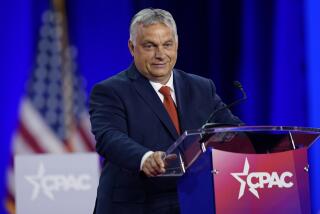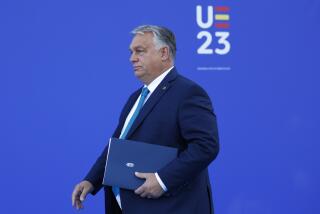Reporter’s Notebook : Stereotypes Fall Behind (Former) Iron Curtain
BUDAPEST, Hungary — Perhaps, in earlier years, President Bush’s tour of Poland and Hungary would have stolen a title fit for Hollywood--”Dancing With the Red Devil,” for instance, or “Eighty Hours Behind the Iron Curtain.”
But these are strange days here, and what for 40 years has been referred to as the Iron Curtain has all but lost that label. At stop after stop--wherever crowds gathered as Bush conducted a campaign-like whirlwind tour through Eastern and Central Europe--that ideological and geopolitical boundary was nowhere to be seen.
There have been some minor missteps, it’s true. In one instance, Bush, seeking to put a local touch on a speech, called the Hungarian economy--burdened by inefficiency and complex, state-ordered pricing systems--a “Rubik’s Cone.” (The famous little puzzle cube--not cone--was invented by a Hungarian, Erno Rubik.)
And never mind that White House Chief of Staff John H. Sununu sought to explain the U.S. limitations on aid to economically strapped Poland by likening the Poles to an undisciplined “young person in the candy store” not knowing “which direction to take.” He apologized two days later.
On the whole, however, this has been a tour in which such miscues have been the exception rather than the rule.
Instead, Bush, typically upbeat, has managed to introduce American informality to a part of the world known for the starch of its Communist leaders. But all the while the trip’s theme, “a Europe whole and free,” remained at the fore.
And so, throughout the tour the stereotypes tumbled, not in the aftermath of a heady dose of Polish vodka or sweet Hungarian wine but in a unique blend of glasnost , perestroika and American flags.
The glasnost and perestroika were served up from a distance by Soviet President Mikhail S. Gorbachev, stirring up political and economic reforms that have left U.S. officials talking glowingly about the prospects for the eventual restoration of free enterprise as the basis of the economic systems here and in Poland. The American flags were dished out, courtesy of the White House, to reaching hands at a mass rally in Gdansk, Poland.
On Kossuth Square, where anti-Soviet activists were shot by Soviet troops during the Hungarian uprising of 1956, anti-government banners were displayed during Bush’s speech. One read: “Don’t Trust the Communists.”
A few years ago--or perhaps even more recently--such defiance would have been unthinkable.
In Warsaw, the President’s motorcade encountered demonstrators at the 17th-Century Radziwill Palace, now the seat of government, where Bush attended a state dinner. “Down with communism!” “Jaruzelski must go!” and “Long live Bush!” they chanted in Polish.
Perhaps the most striking example of the shifts taking place in Poland and Hungary was the presentation of identical plaques to the President and Secretary of State James A. Baker III by Hungarian Premier Miklos Nemeth.
Embedded in the plaques were pieces of barbed wire, said to have come from the ugly boundary fence separating Hungary and Austria. Hungarian troops recently dismantled a stretch of the wire--the very Iron Curtain that once figured so prominently in Western anti-Communist rhetoric.
The removal of the wire, although genuine, was also a public relations coup, and presenting snippets of it was an act worthy of the finest White House advance man.
But not all stereotypes have fallen.
There remains, among some in Poland, the trait of glorifying all things Communist and Soviet.
And so, when a Polish official escorted a group of reporters about Warsaw at the tail end of the President’s motorcade, he couldn’t resist pointing out that the Communist Party headquarters is “the most important building in Warsaw.”
As for the Soviet Embassy, across the street from the government guest house where Bush spent two nights, he drew attention to its size and grandeur. It is, he said, one of the largest buildings in the Polish capital.
More to Read
Sign up for Essential California
The most important California stories and recommendations in your inbox every morning.
You may occasionally receive promotional content from the Los Angeles Times.










